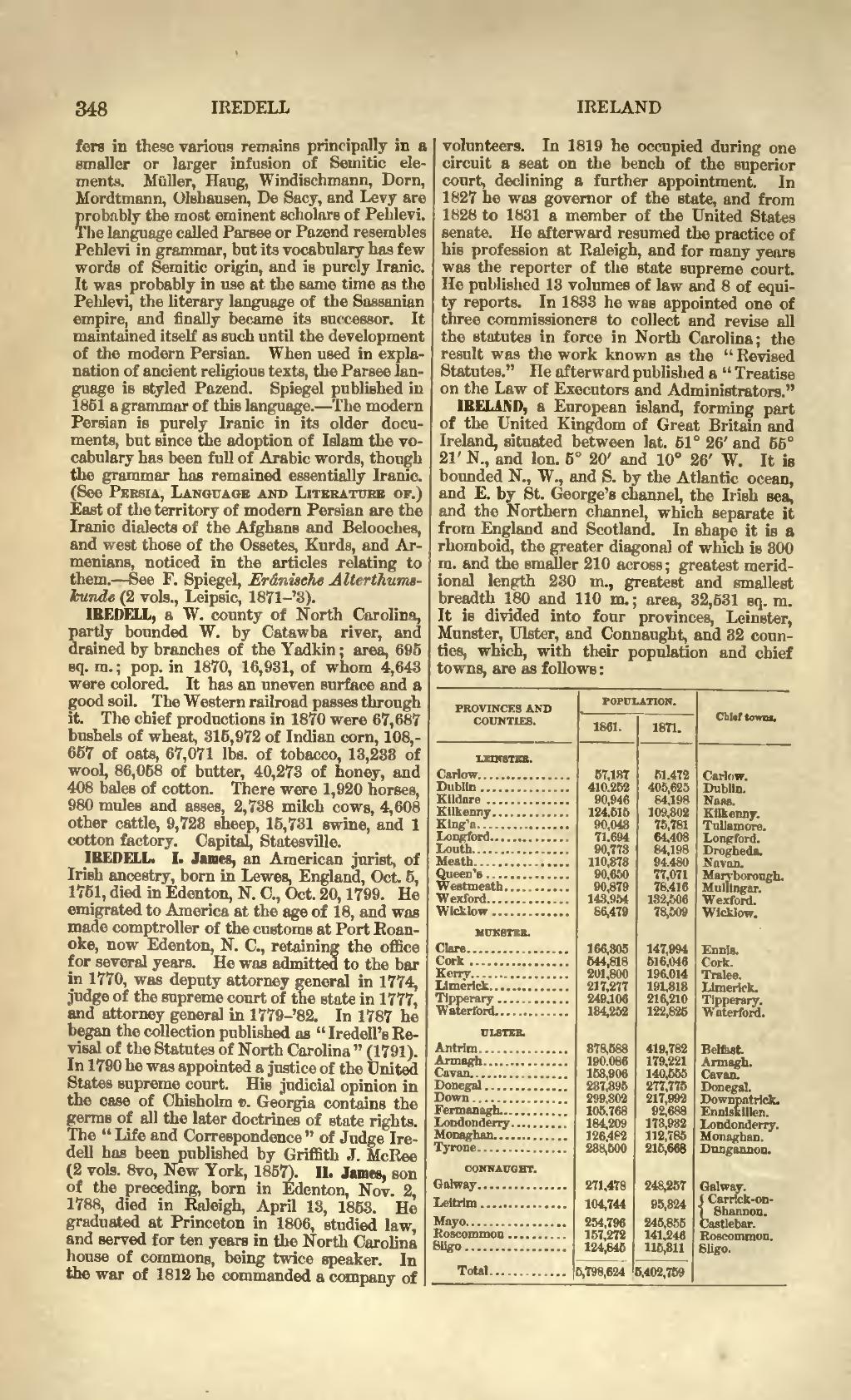348 IREDELL IRELAND fers in these various remains principally in smaller or larger infusion of Semitic ele- ments. Milller, Haug, Windischmann, Dorn, Mordtmann, Olshausen, De Sacy, and Levy are probably the most eminent scholars of Pehlevi. The language culled Parsee or Pazend resembles Pehlevi in grammar, but its vocabulary has few words of Semitic origin, and is purely Iranic. It was probably in use at the same time as the Pehlevi, the literary language of the Sassanian empire, and finally became its successor. It maintained itself as such until the development of the modern Persian. "When used in expla- nation of ancient religious texts, the Parsee lan- guage is styled Pazend. Spiegel published in 1851 a grammar of this language. The modern Persian is purely Iranic in its older docu- ments, but since the adoption of Islam the vo- cabulary has been full of Arabic words, though the grammar has remained essentially Iranic. (See PERSIA, LANGUAGE AND LITERATURE or.) East of the territory of modern Persian are the Iranic dialects of the Afghans and Belooches, and west those of the Ossetes, Kurds, and Ar- menians, noticed in the articles relating to them. See F. Spiegel, Erdnwche Alterthums- Tcunde (2 vols., Leipsic, 1871-'3). IREDELL, a W. county of North Carolina, partly bounded W. by Catawba river, and drained by branches of the Yadkin ; area, 695 sq. m. ; pop. in 1870, 16,931, of whom 4,643 were colored. It has an uneven surface and a good soil. The Western railroad passes through it. The chief productions in 1870 were 67,687 bushels of wheat, 315,972 of Indian corn, 108,- 657 of oats, 67,071 Ibs. of tobacco, 13,233 of wool, 86,058 of butter, 40,273 of honey, and 408 bales of cotton. There were 1,920 horses, 980 mules and asses, 2,738 milch cows, 4,608 other cattle, 9,723 sheep, 15,731 swine, and 1 cotton factory. Capital, Statesville. IREDELL. I. Junes, an American jurist, of Irish ancestry, born in Lewes, England, Oct. 5, 1751, died in Edenton, N. 0., Oct. 20, 1799. He emigrated to America at the age of 18, and was made comptroller of the customs at Port Roan- oke, now Edenton, N. C., retaining the office for several years. He was admitted to the bar in 1770, was deputy attorney general in 1774, judge of the supreme court of the state in 1777, and attorney general in 1779-'82. In 1787 he began the collection published as " Iredell's Re- visal of the Statutes of North Carolina " (1791). In 1790 he was appointed a justice of the United States supreme court. His judicial opinion in the case of Chisholm u. Georgia contains the germs of all the later doctrines of state rights. The " Life and Correspondence" of Judge Ire- dell has been published by Griffith J. McRee (2 vols. 8vo, New York, 1857). II. James, son of the preceding, born in Edenton, Nov. 2, 1788, died in Raleigh, April 13, 1853. He graduated at Princeton in 1806, studied law, and served for ten years in the North Carolina house of commons, being twice speaker. In the war of 1812 he commanded a company of volunteers. In 1819 he occupied during one circuit a seat on the bench of the superior court, declining a further appointment. In 1827 he was governor of the state, and from 1828 to 1831 a member of the United States senate. lie afterward resumed the practice of his profession at Raleigh, and for many years was the reporter of the state supreme court. He published 13 volumes of law and 8 of equi- ty reports. In 1833 he was appointed one of three commissioners to collect and revise all the statutes in force in North Carolina; the result was the work known as the "Revised Statutes." He afterward published a " Treatise on the Law of Executors and Administrators." IRELAND, a European island, forming part of the United Kingdom of Great Britain and Ireland, situated between lat. 51 26' and 65 21' N., and Ion. 5 20' and 10 26' W. It is bounded N., W., and S. by the Atlantic ocean, and E. by St. George's channel, the Irish sea, and the Northern channel, which separate it from England and Scotland. In shape it is a rhomboid, the greater diagonal of which is 300 m. and the smaller 210 across; greatest merid- ional length 230 m., greatest and smallest breadth 180 and 110 m. ; area, 32,531 sq. m. It is divided into four provinces, Leinster, Munster, Ulster, and Connaught, and 32 coun- ties, which, with their population and chief towns, are as follows : PROVINCES AND COUNTIES. POPULATION. Chief towoi. 1861. 1871. LEINSTER. 57,187 410.252 90,946 124,615 90,048 71.694 90,773 110,873 90,650 90,879 143,954 66,479 166,305 M4.MS 201,800 217,277 249,106 134,252 878,588 190.086 153.906 237,395 299,302 105.768 184,209 126,482 288,500 271,478 104,744 254,796 157,272 124,846 51,472 405,625 64,198 109,802 75,781 64,408 84,198 94.480 77,071 78.416 132,506 78,509 147,994 516,046 196,014 191.318 216,210 122,825 419,782 179,221 140.555 277,775 217,992 92,688 173,982 112,785 215,668 248,257 95,324 245,855 141,246 115,811 Carlow. Dublin. Naas. Kilkenny. Tullamore. Longford. Dropheda. Xavan. Maryborough. Mullingar. Wexford. Wicklow. Ennis. Cork. Tralee. Limerick. Tipperary. Waterford. Belfast. Armagh. Cavan. Donegal. Downpntrick. Enniskillen. Londonderry. Monaghan. Dungannon. Galway. ( Carrick-on- 1 Shannon. Castlebar. Roscommon. Sligo. Dublin Kilclare Kilkenny King's Louth Meath Westmeath Wexford Wlcklow UCNBTBB. Clare... Cork Kerry Tipperary Waterlbrd. . . . FLSTEE. Antrim Cavan Down Fermanagh Londonderry Vlonaghan CONNAtJGHT. Lcltrim Total ,798,624 5,402,759
Page:The American Cyclopædia (1879) Volume IX.djvu/360
This page needs to be proofread.
